Long before there was kerosene (aka paraffin) lamp oil, people used vegetable oil lamps for lighting their homes.
These oil lamps are really easy to make and today a lot of people prefer them to kerosene lamps. They are natural, don’t produce toxic byproducts, and can be used in a pinch during power outages.
If you want to make your own vegetable oil lamp, here’s how to do it!
What Vegetable Oil Can I Use for Lamps?
You can use just about any cooking oil as a fuel for a lamp. Other types of fat – such as ghee or butter – will also work.
- Olive Oil: This is the best choice for your vegetable oil lamp. It won’t produce smoke while burning.
- Canola or Sunflower Oil: These are cheap and will burn. However, they will produce some smoke.
- Walnut, Almond, Sesame, Flax Oils: Nut and seed oils are great for lamps. They won’t produce smoke like canola will. However, these oils are pricey so you probably won’t want to use them for your lamp. Cheap olive oil is a better option.
- Ghee or Butter: Traditionally, animal fats (such as whale blubber or fish oil) were used for oil lamps, especially in cold areas where veggies weren’t available. You can actually just put a wick directly in a stick of butter and burn it. These thick fats don’t work as well in jars though.
Used Vegetable Oil for Lamps
After frying food, save the vegetable oil in a jar. You can use this oil for lamps.
Ideally you should filter the oil through a cloth first. Otherwise the chunks of food residue can start to smoke and smell!
Vegetable Oil Lamp Instructions:
There are a few different ways of making a lamp with vegetable oil.
Instead of giving you just one way, I’ll talk about the supplies so you can DIY in your own way.
Container for Holding the Oil
Almost any non-flammable container will do.
To save on oil, look for containers that are wider than they are tall.
For safety, you’ll ideally want a container which entraps the flame.
You’ll obviously want the container to be transparent though so you can actually see the flame inside.
Here are some options:
- Glass Jars
- Clay/Ceramic/Metal Dishes: Old Roman oil lamps were made from terracotta. They were shaped like gravy boats.
- Kerosene Lanterns: You know those antique-style lanterns with a glass globe inside? Even though they are designed for kerosene, you can use vegetable oil in them.

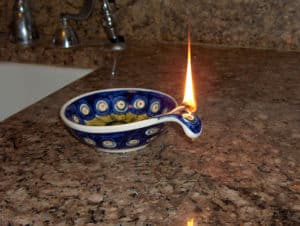
Wick (Soaked in Salt Water)
Anything made out of cotton will work as a wick. Ideally, the wick is made out of a braided material. Otherwise it will burn very quickly. Braided wicks also produce more light. However, in a pinch, you can use:
- Shoe laces
- Strips of old clothing
- String
Wick Holder
Here is where you need to get creative with your vegetable oil lamp.
You need the top of the wick (the part that will burn) to sit slightly above the vegetable oil. Otherwise, the oil will put out the flame.
If you are using a ceramic dish for your lamp, then you can just prop the wick on the edge. This is a bit of a fire hazard though.
Option 1: Wire Coil
For glass jar lamps, you’ll want to use wire to create a stand for the wick.
- Wrap wire around a pencil to create a coil. The coil should be long enough so your wick will stick out of the oil.
- Make a much bigger loop on the end of the coil. This will be your base.
- Thread the wick through the coil.
Option 2: Bottle Cap and Wire
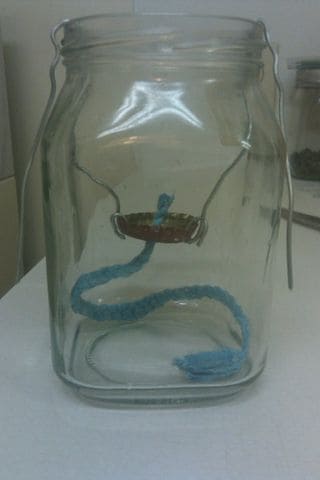
One alternative solution is to use wire + a bottle cap to create a stand.
- Using a hammer and nail, poke a hole through a metal bottle cap.
- Twist the wire to make a holder for bottle cap.
- Put the wick through the hole in the bottle cap. Put the cap in place.
Option 3: Hole in a Jar Lid
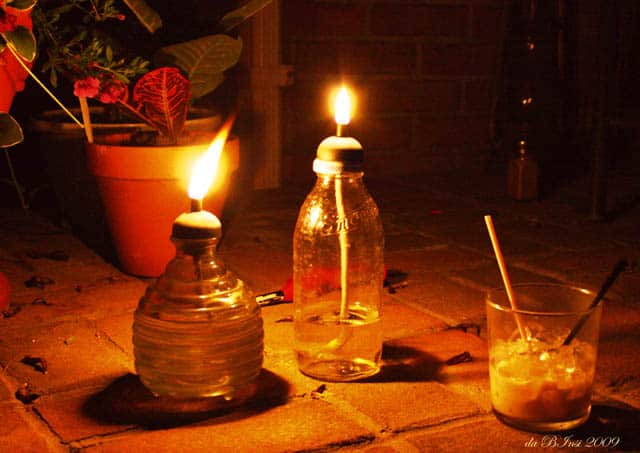
If your glass jar has a lid, you can just poke a hole through the lid and thread your wick through it.
Note that you’ll have to poke air holes in the lid too.
Drape the Wick
If you use a ceramic or metal container for holding your oil, you can just drape the wick off to the side.
Of course, this means you have an open flame. It isn’t as safe as enclosing the flame inside the container.
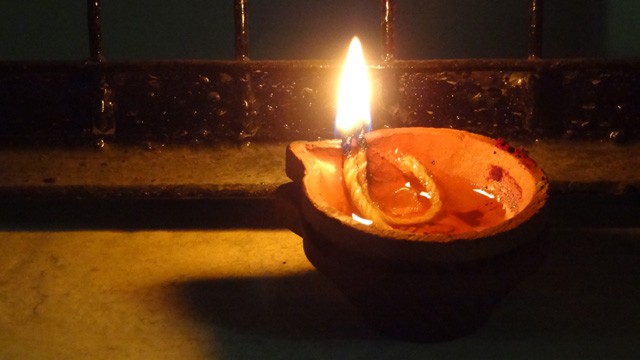
How the Vegetable Oil Lamp Works
The vegetable oil will be drawn up into the wick.
The flame ignites it, causing the oil to vaporize. Even a small amount of oil can burn for a few hours.
Even if you are using olive oil (which is fairly expensive), it still ends up being cheaper than most candles.
Paraffin Lamp Oil vs. Vegetable Oil
Lamp oil that you buy online or from hobby stories is made from petroleum. Sometimes it is called kerosene. Other times it is called paraffin.
They are the same thing – just a highly-refined kerosene oil.
Paraffin lamp oil will not smoke or produce odor as some vegetable oils will.
Flash Point:
Compared to vegetable oil, paraffin lamp oil has a much lower flash point. Flash point refers to the temperature at which it will ignite.
- Vegetable Oil Flash Point: Around 650 F
- Paraffin Oil Flash Point: Around 200F
The lower flash point of veggie oil means it takes longer to ignite. It will burn – but it is not exactly ideal for wicks. As it burns, it will consume the wick quickly.
By comparison, lamp oil will burn off the wick quickly. Very little of the wick will be consumed, meaning your wick will last a lot longer with paraffin lamp oil.
As a general rule: The thicker the oil, the faster the wick will be consumed and the more smoke will be produced.
Lamp Oil Is Still the Best Choice
In a disaster situation where you need some emergency lighting, vegetable oil is a great option for DIY oil lamps.
However, if you are making oil lamps for fun, then your best bet is to buy lamp oil.
It simply burns cleaner and won’t consume your wicks as quickly.
You can find lamp oil (called kerosene or paraffin lamp oil) online for fairly cheap. If you want to really save some money, then choose K-1 kerosene.
K-1 Kerosene Lamp Oil
You can find K-1 kerosene at some gas stations and at hardware stores. It is very cheap to buy and has numerous uses – such as for heating or jet fuel.
Recommended Reading: Best Kerosene Heater for Indoor Use
K-1 kerosene will still produce some odors (it contains sulfur), but the smell is minimal.
Compared to vegetable oil, the K-1 oil will burn cleanly in lamps and won’t eat up your wicks so quickly.
Recommended Reading: How to Make DIY Emergency Candles
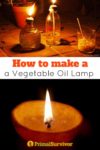




I saw on YouTube that carbon graphite felt is like flame proof and can serve as a wick for oils.
So I bought a sheet of 5mm thick on AliExpress, cut a strip and tried in my old fashioned oil lamp.
To see if I could use discarded deep fryer (vegetable?)oil. Thickness was a tight fit and the wick gear more so frayed it(it’s not as tough a braid that a wick is) than raised when turning it up. I was able to stretch the felt strip thinner helped some.
I dipped the felt before install. It did finally light and burn. Seemed smoke free. BUT the wick had to be high and the flame would die when the oil on the tip was depleted. With or without the glass hurricane.
Even though the lamp oil was full.
So I gave up on that idea.
Back to recycling the fryer oil.
Because I see people say the regular cotton wick gets consumed too fast, no matter what.
I wanted some free winter heat from free oil and I was curious.
Wanted to share my experience here.
Take care
I tried this too and had the same thing happen. There’s a solution though. You need a way to warm up the oil and .ake it less viscose to move through the felt more easily. I cut a segment of copper pipe, rolled the felt up and stuffed it into it in a way where there was a little felt above and below the ends of the pipe.
I took that and put it into the same kind of lamp you described – after making a hole in the original wick holder. It took quite a bit of muscle and demo to get a hole into that but it works and I’m still able to screw and unscrew the top from the reservoir.
Even without the lamp the, the copper pipe and felt is enough to act as a wick in any application.
Thank you, I so enjoyed the information. I’ve been making candles since I was a teenager. Actually, it’s more like remaking. I cut out and save the wax from burnt candles, separated in jars by color (close counts). When I get enough of a color I make new candles. I keep the little metal wick clips from original candles to reuse.
I can’t wait to try your borax, salt tip (I’m assuming water should be added to this). I have several options I use for wicks, my favorite being twine soaked in wax and I’m thinking your borax salt tip may enhance that.
I also use clothespins to hold my wicks but I drape a small piece of tinfoil over the clothespin, I got tired of cleaning the clothespins, lol. You can use that same piece of foil 2 or 3 times. Yes, I’m a miser
Can you blend kerosene with the fryer oil?
Yes, you can. They actually mix very well. Just be warned that neither burn very clean. If you plan on doing this, test it outdoors first.
How well does grape seed oil work? It seems to be thinner than olive oil.
Also, someone left a comment about soaking cotton string in salt water and borax, which wasn’t mentioned in the post. Is that a better solution? If so, what ratios should I use and how long do I soak them for? Thank you.
Can I use a generic white mug (one of the ones sold with graphics) for this? I have a mug that I don’t intend to use, but it is a commemorative gift mug and I’m hoping to repurpose it.
It probably wouldn’t work too well. The sides of the mug would block airflow and also block light. You are better off with shallow dishes.
Great information; thank you. I’ve just bought a kerosene lamp from Amazon and will try it out tonight with kerosene. It’s handy to know that I can use olive oil or canola oil etc. Thanks again.
Hi I am very interested in what you had to say about oil lamps .
I am just learning and we here in Australia preparing for what ever comes this way even on kero fridges and ice boxes we are trying to catch up on as much as we can in the short time that we have.
Kind regards Maria.
heavy cotton string (without any sizing!) done up in a 4 braid makes a pretty serviceable wick about a 1/4 in in diameter. If you need one bigger 8 braid… Salvaged wire from old shipping labels can be inserted up the middle to support the wick if required.
It’s always good to have an alterative for the real thing even if it isn’t 100% in comparison.. That’s Making DO.. I do have three full sized lamps and several gallons of lamp oil in reserve though.
Agree — the key to survival is being flexible, creative and able to adapt. Or, as you said, “make do.”
Can soya bean oil be used as lamp oil instead of olive oil as it’s much cheaper . Is burning soya bean oil be harmful when inhaled?
Yes, it can — but many people will complain that it makes bad smells which might be harmful to breathe in. So, it really depends on how much of a purist you are, ventilation, etc.
Hello, I hope you can help me. I have one of them classic lanterns that you hang anywhere, although it is a modern day production item. I tried organic extra virgin olive oil, because that’s what I have. So it used up the wick very quickly and on a low burn it hardly gives off much light. Is that oil okay to use or am I doing something wrong, although there is not much to do wrong?
Regards Eddie
Olive oil has a higher flash point temperature than paraffin. So, this affects how easily it burns and how much light it will make. To make it work better, you need to:
-Use a thicker wick with a large weave. Don’t use the standard thin wicks. A round 1/4″ oil lamp wick should work.
-The wick must remain saturated at all times.
-The wick will need to be closer to the oil so it can draw the oil into it better (and thus stay saturated).
I also found this advice:
“With the wick, you can wrap it with a flexible wire (solid core), like copper, and use the metal to bend the wick into a little coil with support. Try to expose 1/4 to 1/2 an inch of wick above the oil, and you are pretty much in business.” https://www.thriftyfun.com/Using-Olive-Oil-as-Fuel-for-Oil-Lamps-1.html
If possible I would recommend the citronella oil, I’ve been using it myself in an old lantern cause it both gives off light and helps keep the mosquitoes away, been burning continuously for 2 and a half days and only just put the last of my 1 litre bottle in the lantern
How much does that cost per liter?
My wicks don’t seem to continue burning. Unless very close to the oil. How much salt is added to the salt water treatment of the wick??
About 2-3 tbsp of salt per cup of water. Some people also add 1 tbsp of borax to the mix. If your wicks keep going out though, it might be because the wick isn’t saturated enough and thus only the wick is burning and not the oil. Try to keep the wick shorter and maybe try a larger wick.
Hair oil works too.
Did you learn this the hard way?
I found this very informative. My Husband burns kero in out lamps and I don’t like the smell at all. I am going to experiment with these other options I can get free oil frim the fryer where my son works.
Lamp oil that you buy online or from hobby stories is made from petroleum. Sometimes it is called kerosene. Other times it is called paraffin.
They are the same thing – just a highly-refined kerosene oil.
not so…
Lamp oil is thicker. True Kerosene almost seem thinner that water or alcohol.
Excellent. I learned so much. Just in awe. Wow great info. Covers everything beginners need to know!!
Awesome – let us know how it goes if you make it.
I am about to go to The nature and Try to live on my own. This article is great for me! Thank you very much.
Özgür!
Awesome – let us know how you get on.
Great instructions. Before these instructions I used a wick in container of Crisco (lard). Now I can show my grand kids another use of vegetable oil. Thank you.
Glad you enjoyed it. Let us know how you and the kids get on!